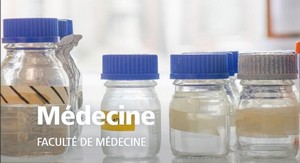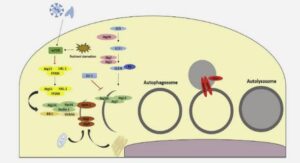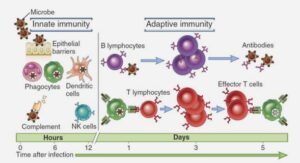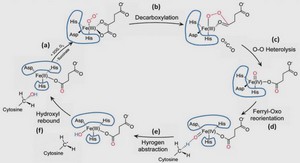Télécharger le fichier original (Mémoire de fin d’études)
Introduction
After osteosarcoma, chondrosarcoma is the second primary bone cancer, representing 20% of bone malignancies. It usually grows in bone (chest, long, basin) and mainly affects adults over 30 years. It forms a heterogeneous family characterized by expression of cartilage-like matrix (Bovée et al., 2005). There are three degrees of chondrosarcoma (grade 1 to 3) defined by cytological criteria (cellularity, size of nuclei, mitoses …) and architectural (organization lobules of different sizes, irregular, extension to the soft parts …) (Evans et al., 1977). Chondrosarcomas are known to have local aggressive behaviour. They may induce pulmonary metastases and become fatal. The survival rate is around 60-70% at 5 years, and the risks of metastasis and local recurrence are correlated with histological grade.
Chondrosarcoma treatment has only few changes over the past 30 years because they are resistant to radiation and conventional chemotherapy (Rosenberg et al., 1999). The standard treatment is surgical resection of the tumor (Kubo et al., 2008). A main hypothesis explaining chondrosarcomas resistance to chemotherapy is the hypoxic microenvironment around these tumors (Onishi et al., 2011).
It is well established that hypoxia acts mainly through intracellular mediators called Hypoxia Inducible Factor (HIF)-1 and -2, which are expressed in chondrosarcomas (at least in high-grade) (Kubo et al., 2008). These are essential transcription factor for maintaining the homeostasis of the cell and oxygen for adaptation hypoxic environment. They are involved in angiogenesis, tumor invasion, glucose metabolism, pH regulation, control of cell proliferation and drug resistance (Zeng et al., 2011).
Hypoxia is an essential feature of a solid tumor microenvironment and is associated with increased malignancy and poor prognostic. Many mechanisms allow hypoxic tumoral cells to modulate glycolysis, cell proliferation, and invasion (Shannon et al., 2003). Hypoxia plays arole in chemotherapy resistance. Indeed, it increases the activity of DNA repair enzymes, the loss of apoptotic potential by mutation of the p53 gene as well as the creation a pH gradient which inhibits intracellular accumulation of the drugs (Shannon et al., 2003).
In this study we examined the role of hypoxia in the resistance to chemotherapy and most particularly to cisplatin. This drug is used for treatment of various tumours as a single agent or combined to other anticancer agents. The main mechanism is generation of DNA lesions and activation of DNA damages followed by induction of mitochondrial apoptosis (Galluzzi et al., 2012). However, cancer cells develop an acute resistance to cisplatin which limits its use in patients (Galluzzi et al., 2014). The mechanisms of cisplatin resistance are not fully understood yet. We show that hypoxia increases the resistance to cisplatin in chondrosarcoma cell line dependent manner. We suggest that this resistance is associated to a reduction of apoptosis.
Material and Methods
Cell culture
Human chondrosarcoma cell line SW1353 was purchased from the American Type Culture Collection (ATCC, Manassas, VA, USA). The human JJ012 and FS090 cell lines were kindly provided by Dr. Joel A. Block (Rush University medical center; Scully et al., 2000). They were cultured in Dul ecco’s Modified Eagle Medium DMEM) supplemented with 10% fetal bovine serum (FBS) (Invitrogen, Cergy-Pontoise, France) and antibiotics (10,000 U/mL penicillin and 10 mg/mL streptomycin in 0.9% NaCl). The cell line CH2879 was kindly provided by Pr. A. Llombart-Bosch (University of Valencia, Spain; Gil-Benso et al., 2003), cultured in Roswell Park Memorial Institute 640’s medium Lonza AG, Verviers, Belgium) supplemented ith 0 % FBS (Invitrogen) and antibiotics (penicillin and streptomycin).
Protein extraction and Western blot Proteins were extracted using RIPA lysis buffer and western blot was performed as previously described (Girard et al., 2014). Antibodies specific for HIF- α 6 0959) as o tained from BD biosciences, EPAS-1 (sc- 3596) and β-actin (sc-47778) were obtained from Santa Cruz biotechnology and PARP (#9542) was provided by Cell signalling.
Cell survival and proliferation
Viable cells were counted using Countess II (Life Technologies) after trypan bleu exclusion. Each count was performed twice, and independent experiments were done three times.
Clonogenicity assay
Cells were seeded at 200 cells/cm2 to proliferate as colonys, due to the distance of the cells. After 10-15 days (around 8 doubling), cell cultures were fixed and colorated with 1 mg/mL of Crystal Violet in PBS-Ethanol 0.5% (Sigma). Colonies of more 50 cells were counted after 2 washing with PBS 1X to eliminate the excess of dye.
Table des matières
REMERCIEMENTS
TABLE DES MATIERES
INDEX DES FIGURES
INDEX DES TABLEAUX
ABREVIATIONS
INTRODUCTION
Le chondrosarcome
A) Généralités
1- Grade histologique des chondrosarcomes
2- Classification histologique des chondrosarcomes
a. Tumeurs bénignes
b. Chondrosarcomes
3- Altération génétique dans les chondrosarcomes
a. Changements précoces
b. Changements tardifs
4- Prise en charge des chondrosarcomes
a. Les chondrosarcomes de grade II et III
b. Les chondrosarcomes de grade I
B) Traitements conventionnels
1- La radiothérapie
a. Mode d’action des irradiations ionisantes
b. Signalisation des lésions à l’ADN
c. Réparation des lésions à l’ADN
2- La chimiothérapie
a. Mode d’action du cisplatine
b. Mécanisme de résistance au cisplatine
3- Mécanismes de résistance des chondrosarcomes aux traitements conventionnel.
a. Expression de la P-glycoprotéine
b. Activité télomérase
c. Perte d’expression de la protéine p16
d. Expression de protéines anti-apoptotiques
e. Hypoxie.
II) L’hypoxie
A) Les facteurs HIFs
1- Structure des facteurs HIFs
2- Régulation des facteurs HIFs
3- Rôle des facteurs HIFs.
a. Le métabolisme : l’effet Warburg
b. La transition épithélio-mésenchymateuse
c. L’invasion tumorale
d. L’angiogenèse
e. Résistance aux traitements conventionnels
B) Ciblage thérapeutique
1- Ciblage du métabolisme hypoxique
2- Ciblage des facteurs HIFs
a. Composés modulant l’activité transcriptionnelle de HIF-α
b. Composés modulant l’expression de HIF-α
c. Composés affectant la stabilité protéique de HIF-α
3- Développement de pro-médicaments activés par l’hypoxie
4- Ciblage des voies activées par l’hypoxie
C) Rôle de l’hypoxie dans les chondrosarcomes
1- Etude histologique des facteurs HIFs
2- Ciblage thérapeutique de l’angiogenèse
III) Approches thérapeutiques contre les chondrosarcomes
A) Nouvelles options de traitement des chondrosarcomes
1- Inhibition des voies de survie
2- Inhibition de la voie de développement Hedgehog
3- Ciblage des voies de l’apoptose
B) L’épigénétique et la méthylation de H3K27
1- La régulation épigénétique
a. La modification des histones
b. Méthylation et déméthylation des histones
2- Triméthylation de l’histone H3K27 et ses régulateurs
a. La marque H3K27
b. La méthyltransférase EZH2
c. Les déméthylases JMJD3 et UTX
3- Ciblage thérapeutique des histone méthylases/déméthylases de H3K27
a. Inhibiteurs de la méthylase EZH2
b. Inhibiteurs des déméthylases UTX et JMJD3
OBJECTIFS
RESULTATS
PROJET I : IMPACT DE L’HYPOXIE SUR LA REPONSE DES CHONDROSARCOMES LA CHIMIOTHERAPIE ET A LA RADIOTHERAPIE
I) Effet de l’hypoxie sur la réponse des chondrosarcomes au cisplatine
II) Effet de l’hypoxie sur la résistance des chondrosarcomes aux rayons X
PROJET II : STRATEGIE THERAPEUTIQUE INNOVANTE DES CHONDROSARCOMES : EVALUATION DE NOUVELLES MOLECULES PHARMACOLOGIQUES
I) Validation de l’effet du DZNep dans un modèle de culture en trois dimensions
II) Le DZNep induit l’apoptose dans les chondrosarcomes in vitro et in vivo mécanisme indépendant d’EZH2
III) Effet chronique du DZNep chez des souris immunocompétentes
IV) Le DZNep synergise l’effet apoptotique du cisplatine dans chondrosarcomes-
V) Ciblage des histone déméthylases UTX et JMJD3 dans le traitement chondrosarcomes
DISCUSSION GENERALE ET PERSPECTIVES
REFERENCES BIBLIOGRAPHIQUES
ANNEXES





